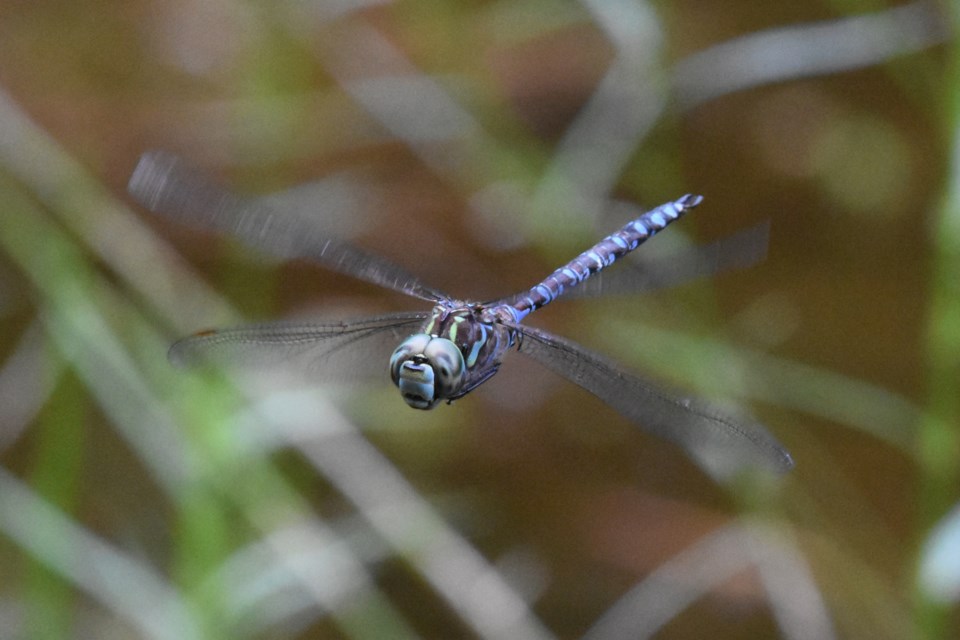Spiders make some people jump. Bees and hornets make some people cringe. Mosquitos and deer flies make some people crazy. And then there are the dragonflies. When a dragonfly flits nearby, most people take note, not from fear but by fascination, as dragonflies can be big, bold, and beautiful.
These fairly large insects are so unique, in so many ways. With their two pair of wings they can fly in six directions (up, down, forwards, back, right side, left side) as each wing is independently operated. Although, when I think about it, hummingbirds can do that with just one pair of wings. Just saying.
With those four wings operating at 30 beats per minute, you won't hear the frantic whine like you do with a mosquito at 600 beats per minute. The wings are quite strong despite being less than paper thin. Although transparent, the network of strong veins provides rigidity and thus you get speed versus weight. A good-sized dragonfly can move along at about 55 kilometers an hour.
Found worldwide and for many millennia, dragonflies have been featured in several cultures. In Japan the Samurai used them as a symbol of power and agility; in New Age totems dragonflies are said to represent the wisdom of transformation and an adaptability in life. Beginning in China, there is a saying that if a dragonfly lands on your head you will have good fortune that day. However, if you encounter a dead dragonfly, bad luck will descend upon you.
Speaking of transformation, the dragonfly life cycle is certainly about mastering two elements: water and air. Eggs are laid on aquatic vegetation, including somewhat submerged rotting logs, and the larva emerge as underwater critters. Depending on the species, this aquatic stage can last from a year to several years.
As a larvae, a dragonfly nymph is as dangerous a predator as good ol' T-rex is portrayed in the movies. Tadpoles, minnows, and larva of beetles and mosquitos are all consumed with great gusto. Lacking teeth but equipped with a powerful set of mandibles, these guys patrol the bottom of marshes, streams and rivers with great efficiency. Some species have an elongate shaped larva, while others (usually river related) are quite round.
As time goes by, the dragonfly larva shed their skin several times until ready to transform into a flying adult. This switch in habitat is profound, leaving the underwater world behind and now learning to dominate the element of air.
An adult dragonfly has two tasks, both involving flight: one is to mate and the other is to hunt. With a bit of careful observation (better known as sitting quietly in the sun beside a calm patch of water, such as on a dock in the bay) you will notice certain hunting and mating displays. A favored perch site is utilized that provides the males with a commanding view of the nearby streambank, whereas the females tend to flit along the watercourse, seeing if any of the boys are interested in striking up a conversation of sorts.
One of the biggest pluses of having dragonflies in the neighbourhood is that they eat mosquitos, lots of mosquitos, both as larva and adults. As an underwater hunter the dragonfly nymph shoots out its mouthparts and catches a wriggling mosquito larva; as an adult the legs are used as the capturing device. While flying and using their excellent eyesight, a passing innocent mosquito is targeted; six bristly legs are dropped down and locked together like a basket or tiny butterfly net. A deft swoop and one less mosquito or deer fly lives by the pond.
While still in flight the dragonfly bends its head downwards and using those powerful and extendable mandibles, it grabs the prey and eats with relish.
What's really nice to know is that an adult dragonfly eats between 30 and 100 mosquitos a day. Yes!!
Should you get a close up view of a dragonfly, you will notice that they have large compound eyes. This allows them to see 360 degrees, so forget about trying to sneak up on one from behind. I've found it best to just show myself, then stand still and let their curiosity bring them over to me. It's kind of weird being scanned by a hovering insect, but it works. Bonus is that it may catch one of the bothersome deer flies buzzing around my head.
Mid-summer provided the most diversity in dragonfly watching, but some species are still in the air by autumn. A few species even migrate to the warmer States for winter, which is an awesome trait for an insect with very little brain.
On your next trip to the corner store to buy a lottery ticket, make sure you pass by a wetland and try to lure a dragonfly to land on your head. Good luck with that! (And if it works, remember who set you up!)
